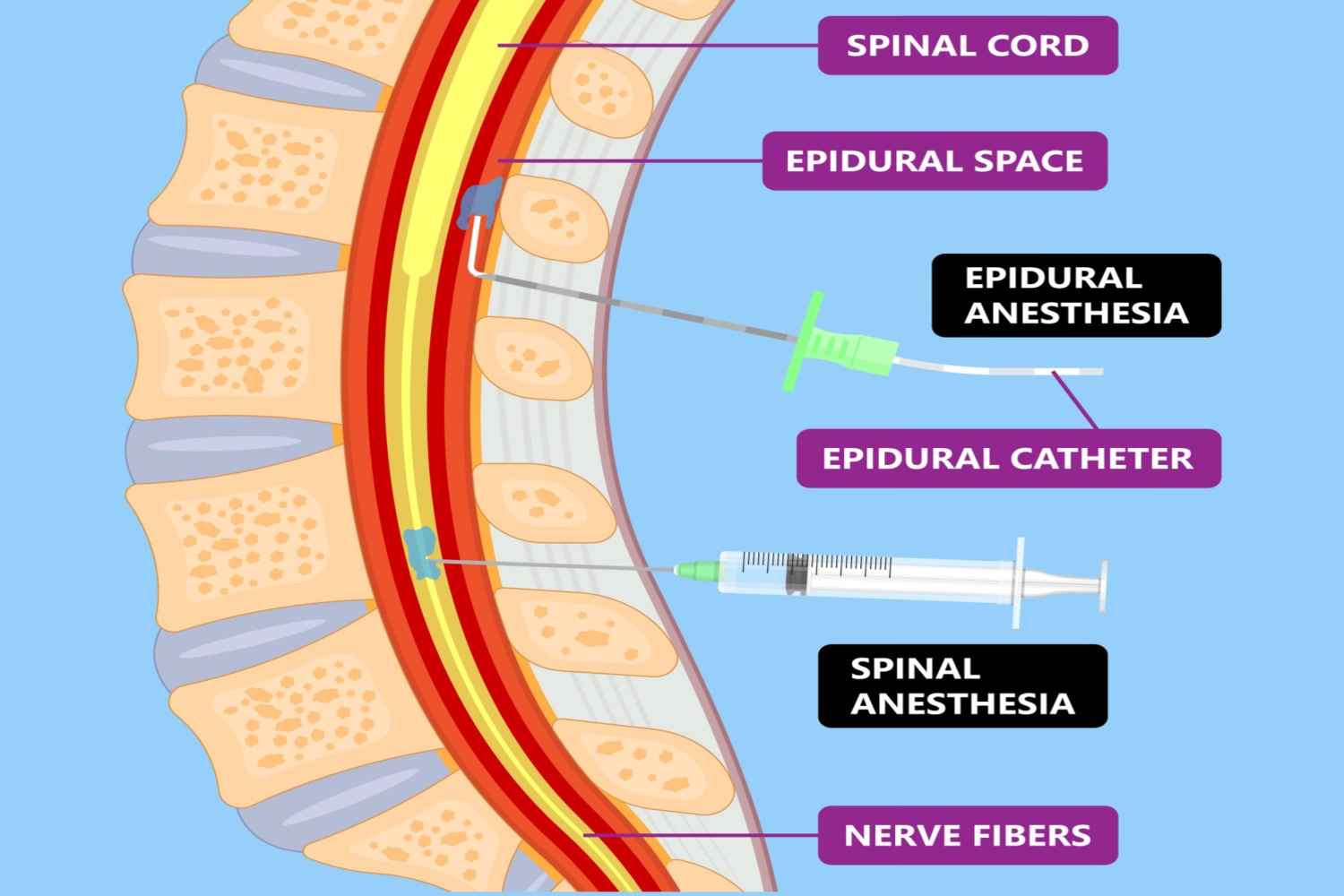
Giving birth to a child is an experience that every woman wants to experience. As the day of delivery approaches, women start thinking and searching around for pain relief options. It’s a good time to head to the hospital and ask your doctor about a detailed birth plan and pain management options. Let us understand the process of epidural during pregnancy and how it helps in pain relief.
An epidural injection is one popular and safe option for pain relief during labor. It can be a good alternative for your pain management. Hence, a better understanding of how the epidural is given, the benefits, and the possible risks associated with it can help you prepare better.
What Is An Epidural?
An epidural is one of the most common and effective types of anesthetic used to relieve pain during labor.[1] It is a procedure where an expert injects a local anesthetic into the space around the spinal nerves of the lower back. This numbing medicine creates a band of numbness extending from the belly button to the top of the legs. Epidural during pregnancy allows the pregnant woman to stay awake during labor and can feel the pressure of labor without any pain.
How Does an Epidural Work?

The epidural works by the use of injecting a catheter into the epidural space in the lower back. This helps in administering the pain-relieving drug that helps in numbing the birth canal and the lower abdomen. The needle is removed after insertion, but the catheter remains in the spine. It takes around 15 minutes for the pain medication to start working.
What’s The Difference Between Epidural Analgesia And Epidural Anesthesia?
Analgesia is another term for pain relief. Epidural analgesia is pain relief without losing any consciousness or loss of any movements. This is used in providing pain relief in normal labor. On the other hand, anesthesia means the loss of physical sensation with or without the loss of consciousness. Epidural anesthesia is helpful in surgeries where the doctor wants the patient to not feel any pain and there are no movements during the procedure.
What Are Epidurals Used For?
Epidural are quite common during pregnancy. It is used in a variety of conditions. Some of them are:
- Providing pain relief during labor and childbirth.
- As an alternative to general anesthesia in a few surgeries to provide anesthesia.
- To relieve pain after surgeries as a postoperative pain management. It works to provide prolonged and effective pain relief after surgeries. [2]
- To manage chronic back pain and issues like spinal stenosis, herniated disk, and pinched nerve.
What Are The Different Kinds Of Epidurals?

There are different kinds of epidural based on certain factors. For delivery and childbirth, there are two kinds of epidural.
1. Epidural With a Catheter
In this type, the anesthetist delivers the medicine into the lower back with the help of a catheter. The catheter after insertion remains in the epidural space so that more medicine can be delivered if it needs to.
2. Combined Spinal-Epidural (CSE)
It is a combination of two injections, which are a spinal block (spinal injection) and an epidural. This combination provides better pain relief than an epidural alone. As it involves lower doses of medications, numbness is not much in the lower half. This allows changing positions and movements. Hence, it is also called a walking epidural.
How Common Are Epidurals?
Epidural is one of the most popular methods of pain relief during labor and delivery. It is a gold standard for pain relief during childbirth [3]. It is commonly used in cases of lower back pain with the use of epidural spinal injections.
Who Shouldn’t Get An Epidural?

Everyone cannot take an epidural during pregnancy. There are certain contraindications too. Hence, providing a detailed medical history is very important. The following people should avoid getting an epidural:
- People with blood clotting disorders.
- People using blood thinners
- Drug allergies towards anesthetic.
- Poorly controlled diabetes
- Infection of the back
- Difficulty locating epidural space
- Lower platelet counts [4]
How Do I Prepare For An Epidural?

It is a minimally invasive procedure that requires following certain instructions. Your healthcare provider will guide you thoroughly about the dos and don’ts before the procedure.
- Fasting for at least 6 hours before the procedure.
- If you are on blood thinners, then this needs adjustments.
- You may not be allowed to drive after the procedure. So it is better to have someone accompanying you.
- You must avoid hot baths, and swimming for a few days after the procedure. This is to avoid the risk of getting infections.
How Long Does an Epidural Last?
The effect of an epidural during pregnancy will depend on the type of epidural you get and on the kind of medicine. In general, the duration of different epidurals is:
- Epidural with a catheter: A continuous flow of medicine can be given by using a catheter. Once the medicine stops, the numbness remains for a few hours. After that, the anesthesia wears off.
- Single injection: The effect lasts for a few hours.
- Epidural steroid injection: The effect of pain relief varies. In people with a new disc herniation, there can be permanent relief. In people who have chronic pain, pain relief can last for 3-6 months or more.
What Are The Advantages of Getting an Epidural?

The process can be beneficial to a lot of people. Mostly, Epidural during pregnancy is of great use during labor . In the following ways, it can be useful in a pregnant woman:
- It is an effective way to minimize pain during the painful process of labor.
- The woman can move around in her room and even push when it needs to.
- It’s a safe way of pain relief and doesn’t affect the baby [5].
- In cases of prolonged labor, it can help the woman sleep as well.
- In cases of a Cesarean section delivery, the woman can stay awake during the procedure.
- It can start at any stage during the process of labor.
What Are The Risks or Complications of Getting an Epidural?
Although the procedure is very safe, there can be a few complications:
- Drop in blood pressure during the procedure, leading to lightheadedness.
- Severe headache owing to spinal fluid leaking.
- Infections like epidural abscess, osteomyelitis, and meningitis.
- Hematoma or blood clot due to accidental blood vessel damage during the process [6].
- Nerve damage at the site of injection. There can be temporary loss of bowel and bladder control as well.
Before your big day arrives, get yourself all the information about an epidural injection. For a lot of women, it is one of the best options. If you think it can be a good alternative for you, then discuss it in detail with your doctor.
FAQ’s
1. Can Getting an Epidural Cause Long-Term Side Effects?
Although rare, an epidural during pregnancy can lead to some long-term complications like chronic pain and neurological deficit due to nerve root damage. Permanent paralysis can also occur.
2. What’s The Difference Between an Epidural and a Spinal Block?
In an epidural, the injection is given in the epidural space around the spinal nerves. In a spinal block, an injection is given into the dural sac around the spinal nerves. The effect is immediate in a spinal block, while it takes around 20 minutes for an epidural to act.
3. How Painful Is An Epidural?
There can be a little discomfort while injecting the medicine. The area is usually numbed before giving the injection. This can help prevent the pain.
4. What Are The Side Effects of Getting an Epidural?
As with any other minimally invasive procedure, the side effects of an epidural include infection, and bleeding at the site. There can be severe headaches as well as a drop in blood pressure.
5. What is The Purpose of Epidural?
The primary purpose is to provide pain relief during labor and childbirth, in certain surgeries, and for the management of chronic pain.
6. Does Pushing Hurt With Epidural?
A woman can feel the contractions with an epidural with no pain. Hence, pushing with no pain becomes quite effective during labor.
References
- The experience of giving birth with epidural analgesia – [https://www.sciencedirect.com/science/article/abs/pii/S1871519214000067]
- Epidural Narcotics for Postoperative Analgesia – [https://journals.lww.com/anesthesia-analgesia/abstract/1980/07000/]
- Association of epidural analgesia during labor and early postpartum urinary incontinence among women delivered vaginally: a propensity score matched retrospective cohort study – [https://www.ncbi.nlm.nih.gov/pmc/articles/PMC10504782/]
- Safe Epidural Analgesia in Thirty Parturients with Platelet Counts Between 69,000 and 98,000 mm-3 – [https://journals.lww.com/anesthesia-analgesia/fulltext/1997/08000/]
- Effects of Epidural Labour Analgesia in Mother and Foetus – [https://link.springer.com/article/10.1007/s13224-017-1063-7]
- Subdural Hematoma Associated With Labor Epidural Analgesia: A Case Series – [https://rapm.bmj.com/content/41/5/628.abstract]
